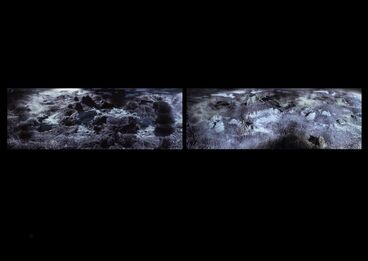Authors:
Supervision:
Prof. Jürgen Klauke
Prof. David Larcher
Prof. Dr. Siegfried Zielinski
Prof. Jürgen Klauke
Prof. David Larcher
Prof. Dr. Siegfried Zielinski
Project type: Diplom
A production of the Academy of Media Arts Cologne.
zgodlocator

Authors:
Authors:
Engineering: Albert Bleckmann
Sound Programming: F.X.RandomizAuthors:
Year: 1999
Categories: Installation, installation
Categories: Installation, installation
Project type: Diplom
Like the beginning of the twentieth century, physics and the life sciences hold a powerful fascination for young artists of today. They engage with system transformations, powered frequency modulators, the pulverization of metals, the breakdown of liquids, dynamic geometry, morphogenesis, particle accelerators, and the design of interfaces between machines and their users. They each do this in their own individual way, in close alliance and with frictions to their exuberant imagination, their impatience, and their strong drive to realize what they are seeking to realize. artistic research is not work on a concept, but working and concentrating on individual things. Interface design has emerged as a focus where contrasting concepts of creative work with and on computer- centred media confront each other. This boundary, which i think is more aptly named in german Schnittstelle (cut- off line), at once both separates and joins two different spheres: on the one side the world of those who utilize the machines, and on the other the world of active machines and programmes. Technological developments, as well as the dominant media concepts of the 1990s, aimed at making the boundary between the two imperceptible. The idea was that one should learn to use a computer without noticing that one is dealing with an algorithmically constructed machine for calculations and simulations. one should be able to immerse oneself in a so-called virtual reality without feeling and, even more, without knowing that one is dealing with a construction of surfaces and time responses that are precisely pre-structured and calculated. For the user the computer was presented like a camera obscura; one can take pleasure in its effects and one can work with it, but one does notneed access to the way it functions. Against the dominant trend of smooth- functioning technological and semiological ergonomics various artists continued to experiment in collaboration with programmers, physicists, and engineers on how it would be possible to enable and develop dramaturgies of difference, also with advanced technologies. Following the classic film and video avant- gardes they insisted that the technical worlds remain accessible as artificially constructed worlds: to construct the interface in such a way that there would be tension with the world beyond the machine would enhance the pleasure in these media- worlds and not reduce it. It is in such a tradition that zgodlocator operates, a work created in the late 1990s by the austrian artist herwig Weiser in collaboration with the electrical engineer Albert Bleckmann and the techno musician F.X.Randomiz. The object of the work’s operative access to the computer is not the software, but the body within which the programmes run, the hardware. Weiser turns discarded computers into granulate and extracts their most valuable components: gold, silver, platinum, and especially ferrite, which is contained in the magnetic deflecting coils of monitors, amongst other things, as well as ferrofluid, a heavy oil which is present in small quantities in every computer. under a shimmering sand landscape and the oil, Weiser installs sets of batteries which can be activated in various combinations via a control unit. Visitors hook up to the techno drama as players using simple manual controls and unleash dynamic turbulence in the materials. The drama has its own sound. sensors register the noise of the computer scrap when it moves, which is fed into a special programme that amplifies the sounds and can be played by the intervention of the participants. in this way the apparatus also becomes a musical instrument. in zgodlocator dead hardware material is given new technical life, reanimated. expanded cinema of a special kind emerges: in four dimensions, in close interconnection of image and sound, ever- new micro- industrial landscapes of strange beauty are generated by the participants.(...) Siegfried Zielinski, The operation of zgodlocator : Thinking about Art after the media: Research as practised culture of Experiment, in: The Routle
Collaboration:
Idea and Realisation: Herwig WeiserEngineering: Albert Bleckmann
Sound Programming: F.X.Randomiz
Supervision:
Prof. Jürgen Klauke, Prof. David Larcher, Prof. Dr. Siegfried ZielinskiA production of the Academy of Media Arts Cologne.
Auszeichnungen
Festivals
Please wait






